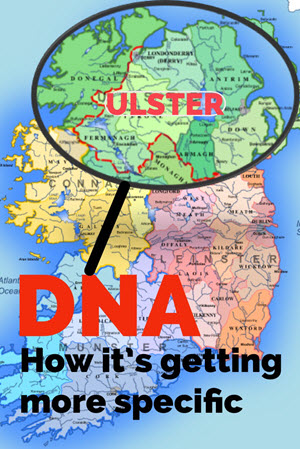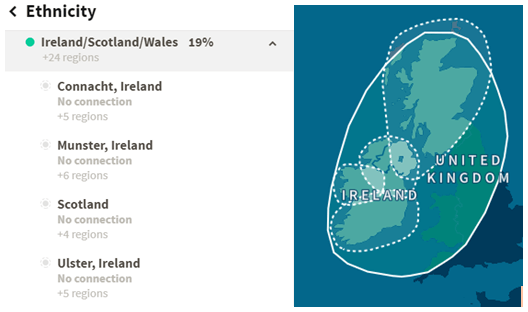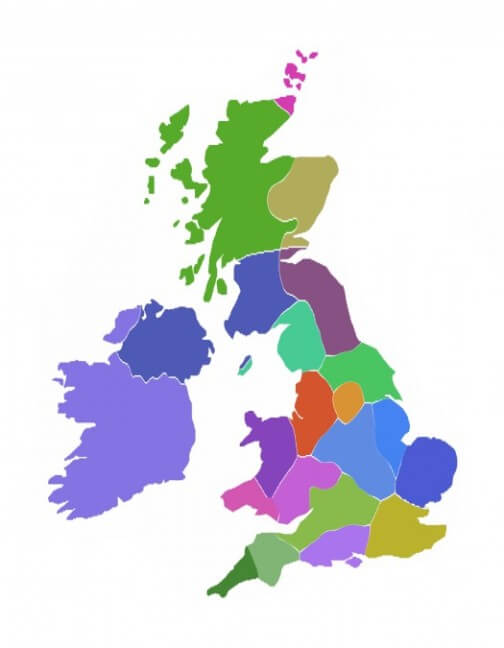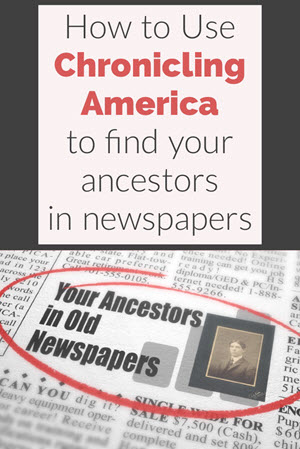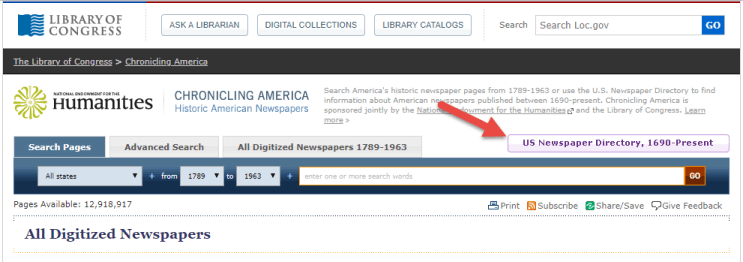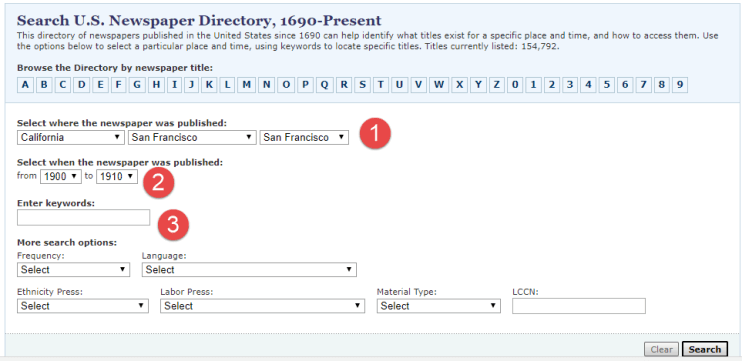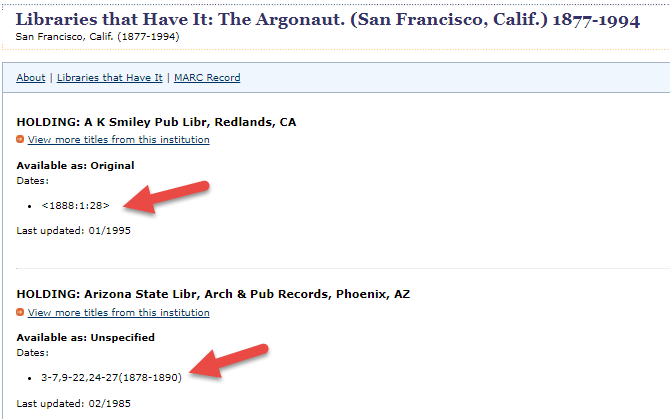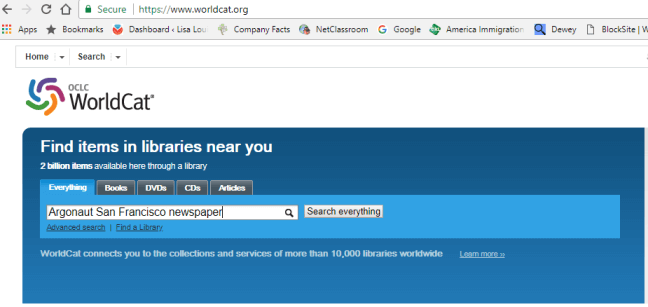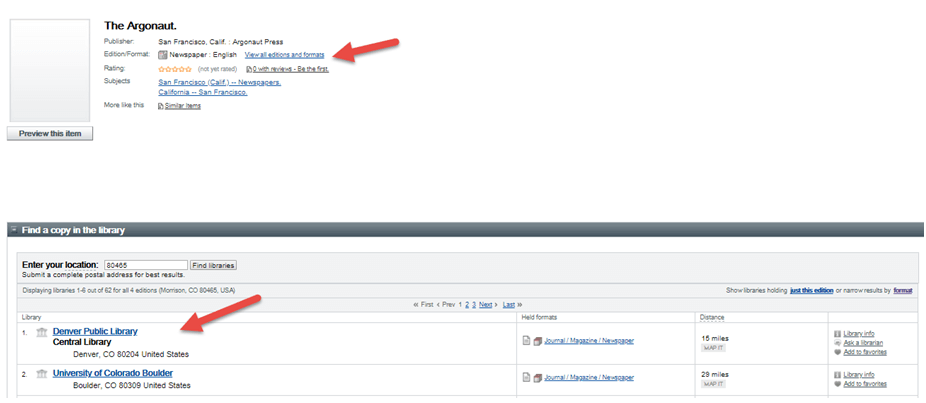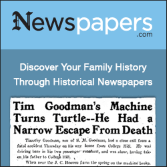Blog

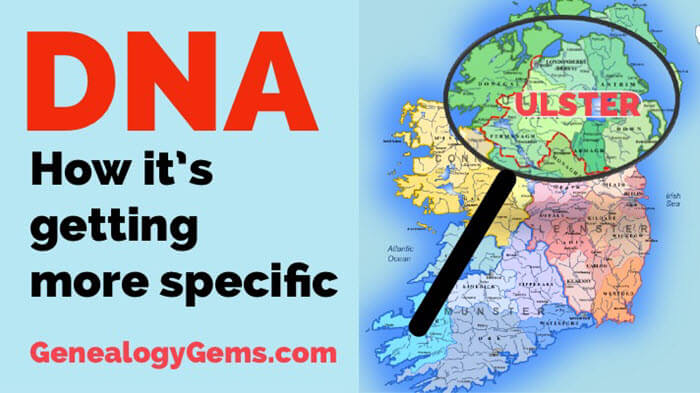
DNA Ethnicity Accuracy: How It’s Getting More Specific
When it comes to the accuracy of DNA ethnicity results, there’s some good news: they’re getting more specific. Your initial results that said “Irish” may now point specifically to Ulster. Here, Your DNA Guide Diahan Southard talks about this promising progress.
One of the questions I get asked most often is to predict the future of genetic genealogy. While I don’t have a crystal ball, I am certain that the future of genetic genealogy holds two things: automation and specificity. We will save the automation discussion for another day (it was hinted at in RootsTech announcements by both MyHeritage and Living DNA) and focus here on the exciting topic of specificity.
DNA ethnicity accuracy: Specificity on the rise
Since the launch of the autosomal DNA test, we have seen an incredible increase in the specificity of our origins reports. In 2007, 23andMe was breaking down your heritage into three main categories: Europe, Asia, and Africa. Now, 11 years later, after several revisions, they have released a new update expanding their origins product from 31 categories to 150! That’s an increase in specificity of 4,900%!!!! All companies are moving in this same direction, with AncestryDNA releasing a small update in April of 2018, to try to provide more detail to the story of your ancestral heritage.
This trend toward increasing specificity also appears in reports from academia. For example, in December of 2017, there was a study released by the Royal College of Surgeons in Ireland working with the Genealogical Society of Ireland. The study details a component that is especially important to genealogists: time. While it might be interesting to know that you had an ancestor who once walked the moors, it would be even more valuable to know when he was there.
In this study, they can see both the current genetic clusters in Ireland (they report 10) but also measure how genetically similar those clusters are to other places. That means we can not only tell you where you are from in Ireland, but also where you were before that. It’s a bit like the sticker you see on the fruit at the grocery store. Right now it is in your store, but the sticker tells you where it was before that.
AncestryDNA origins reports
This same kind of research is reflected in AncestryDNA’s Migrations, which are a feature of their origins report. Migration communities, like Lower Midwest Settlers, identify your ancestral locations hundreds of years ago, as opposed to the Regions, like Europe West, which identify your ancestral locations thousands of years ago.
Sticking with the Irish theme, we see that AncestryDNA places Ireland in a region with Scotland and Wales. This large region is then broken up into four subregions, each with its own subregions, for a total of 24 different Irish categories. (You can view this image by clicking on See all 150+ regions at the bottom of the ethnicity window.)
Much like the study from academia in Ireland, we can track these Irish groups through time using the tools at AncestryDNA. Essentially, if you find yourself in any of the subregions, then you know that your connection to that particular place was likely within a genealogical timeframe (the last 300 years). What if you do not yet find yourself in a subgroup, but as shown in the example here, you see simply no connection to these subregions? It either means your connection to Ireland is farther back than 300ish years, or that the subregion you are from has not yet been defined.
Living DNA ethnicity categories in UK
Currently Living DNA has the most specificity in the UK as they can distinguish between 42 regions in England, Wales, Ireland and Scotland (map shown here). Living DNA has announced similar regional projects in other countries, including Germany.
But even with this specificity, it can still be tricky to make genealogical connections between your maps and your family tree. In the coming months and years, even that will change. As the databases get bigger, it will be the connections between people who are tested that will add to the layer of genealogy specificity that we are missing. In other words, it will be less about whether you have a specific piece of DNA tagging you as from Cork, Ireland, and more about the fact that your DNA connects to you to an entire group of people who have documented ancestors from Cork. This may seem like a small distinction, but it makes all the difference, and is the driving principle behind AncestryDNA’s Migrations tool, and what Living DNA is hinting at as well.
So, what will the future hold? Nobody has all the answers, and that is part of the fun of it. But one thing I am certain of: the future does hold more specific answers to our genetic genealogy questions.
Did you hear?
We have added 21 of Diahan Southard’s DNA tutorial videos to our Premium Membership, which is now Premium eLearning! DNA is a gateway to genealogical discoveries, so it pays to know all you can about using DNA in your family history research plan. We’ve organized Diahan’s comprehensive DNA tutorial series into four categories: General DNA (including beginner), Autosomal DNA, Mitochondrial DNA, and YDNA. Watch all of them or start with what you most want to learn now. And remember, as fantastic as this DNA series is, it’s only one of the many Premium video topics you’ll have exclusive access to with your Premium eLearning. Click here to learn more.

The Author: Diahan Southard
Your DNA Guide
Diahan is Your DNA Guide at Genealogy Gems! She has worked with the Sorenson Molecular Genealogy Foundation, and has been in the genetic genealogy industry since it has been an industry. She holds a degree in Microbiology and her creative side helps her break the science up into delicious bite-sized pieces for you. She’s the author of a full series of DNA guides for genealogists.
Disclosure: This article contains affiliate links and Genealogy Gems will be compensated if you make a purchase after clicking on these links (at no additional cost to you). Thank you for supporting Genealogy Gems!
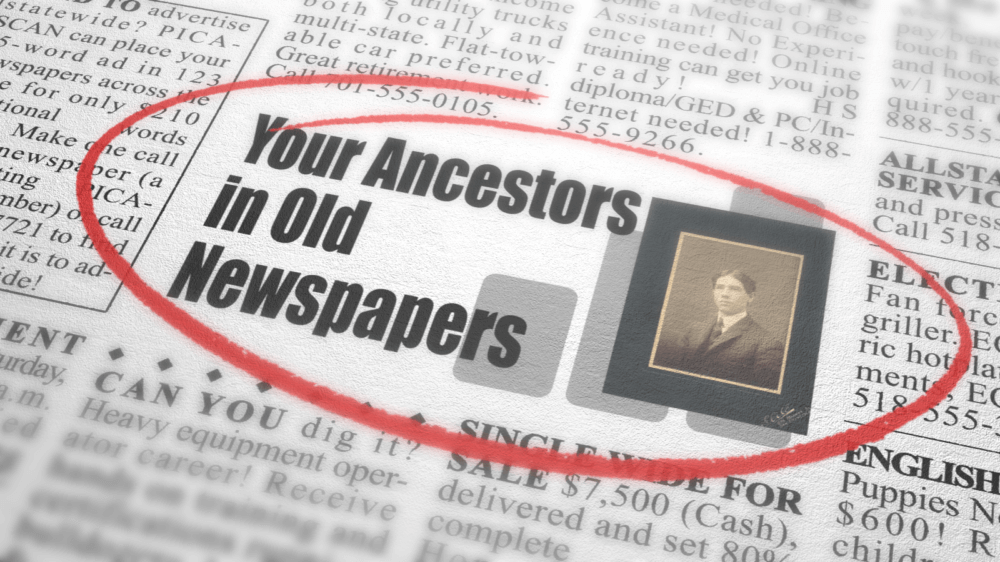
How to Use Chronicling America to Find Your Ancestors’ Hometown Newspapers
Finding old newspapers from your ancestors’ hometown isn’t always easy. Here’s how to use Chronicling America to identify the newspapers that were in print at the time. Those issues may not be online, so Chronicling America also points you to copies of those newspapers at libraries and archives.
In the new Genealogy Gems Premium Podcast #158, I spoke with Deborah Thomas at the Library of Congress. She manages one of my favorite websites for family history: the free historical newspaper site, Chronicling America. We talked about its amazing treasure trove of digitized newspapers: what’s there, what’s coming, and tips for searching them.
But only 1.5% of the 155,000 newspapers published over time in the U.S. newspapers have been digitized at Chronicling America. So you’ll want to look those ones up and locate them offsite. The good news is that there’s a lesser-known tool at Chronicling America to help you do just that. It’s called the US Newspaper Directory. Let’s walk through using it step-by-step.
How to Use Chronicling America to Find Your Ancestors’ Hometown Newspapers
- Go to the free Chronicling America website (no login needed).
From the home page, click the US Newspaper Directory, 1690-Present button on the top right:
The US Newspaper Directory is the most comprehensive database in the world for historical U.S. newspapers. It contains every newspaper known to the Library of Congress. That makes it the perfect place to find the newspapers that were printed in your ancestor’s hometown in any given time and place. The directory will provide you with a library catalog of holdings of these papers.
2. Fill in the blanks.
As shown below, first select the state and county (1). You may also select the city, but for smaller towns or rural areas, you may want to look at all papers that cover the county first. Neighboring towns or cities (even across county lines) may have reported on events local to your family, so it’s worth running a few searches. My tip: use Google Maps to find names of nearby towns. After you select the place, then narrow down a time period (2). Below is a search for newspapers in print at the time of the 1906 San Francisco earthquake, which affected my family. The image below also gives you a third type of selection criteria to focus on specific newspapers, such as those with a particular keyword in the title, or those printed in English or geared toward a particular occupation (3).
3. Choose a newspaper.
Below is a list of results from the above search, narrowed down to just English-language papers. There are still over 400! Some are multiple entries for the same paper, with different formats. Some may be less likely to mention my family, such as certain immigrant-oriented or political papers.
I like to start with the ones that are already online, as indicated in the boxed text above. Click on one of those items, and scroll to the bottom of the catalog description to where it says Related Links, as shown below. Click the link to browse online issues.
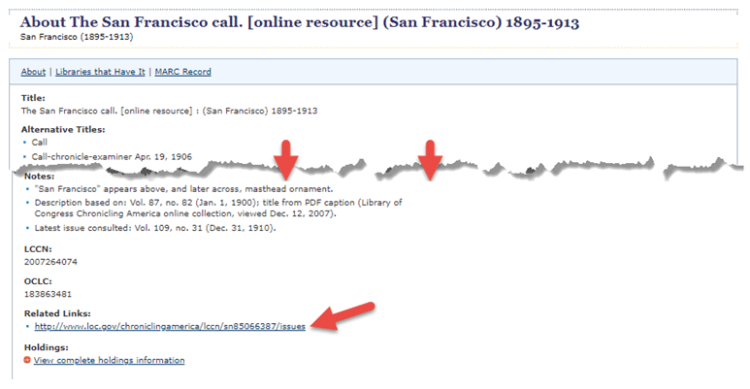
Unfortunately, you can’t search within just those issues, you can just browse. However, because this is an “online resource”, you could go back to Chronicling America’s home page and search by date range, name and keyword for that newspaper and your ancestor’s name in it (as shown in the following example.)
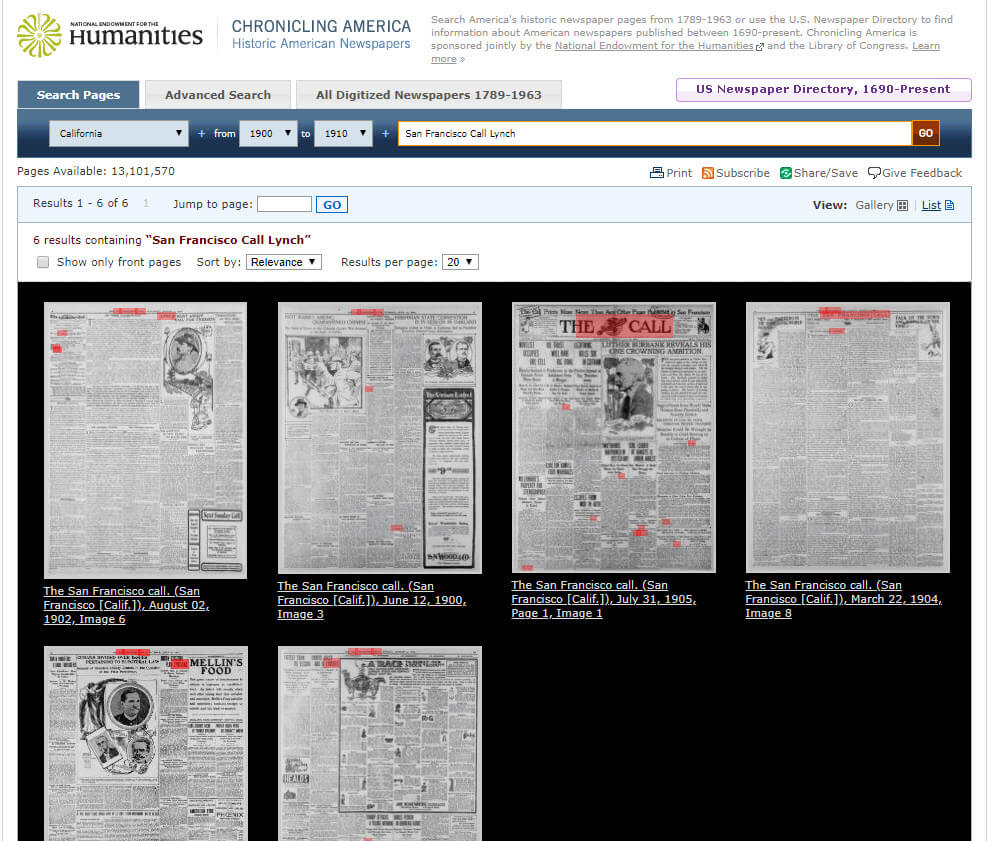
4. Turn to offline papers.
If there are issues of this newspaper that aren’t online, the US Newspaper Directory can still help. In the above entry, see where it says Libraries that Have It just below the title of the newspaper? Click that link and you will see a list of library holdings, as shown below. Watch for the issue dates held at each library. You may have to scroll through several library holdings before you find the dates you want. (Remember, there may be multiple entries in the catalog for that same newspaper in different formats, so go back to your search results to look for additional library holdings mentioned in other entries.)
5. Get access to an offline newspaper.
Unfortunately, we can’t click from this point directly to the library holding of these issues. Instead, open a new window in your web browser and go to www.WorldCat.org, an enormous compiled catalog from thousands of libraries. Type the title in the search box and include the keyword newspaper, and then click Search Everything.
Clicking on the first search result in WorldCat takes you to The Argonaut’s entry in WorldCat, shown below. Here you may look toward the bottom of the entry to see all libraries with that newspaper. Enter you zip code in the Enter your location field and click Find Libraries and WorldCat will display the results in the order of their proximity to you.
On the right side are links to view each’s library information or contact a librarian. Use either option to explore the possibility of having copies made of specific articles, like an obituary, or seeing whether they would lend their copy to a library near you via inter-library loan (they probably won’t send original issues, but may be willing to lend a microfilmed copy). If you don’t find a workable library here, click the View all editions and formats link near the top of the entry. This will reveal additional options for accessing the item.
Get the scoop on your family in old newspapers
Here are more ways to learn about genealogy research in old newspapers:
- Genealogy Gems Premium eLearning members can listen to the Chronicling America interview in the Genealogy Gems Premium Podcast episode #158 (click here to learn how to become a member).
- My book, How to Find Your Family History in Newspapers, is a great choice for starting-line-to-successful-finish how-tos.
- Keep reading these articles on my blog that are all about using newspapers for genealogy!

About the Author: Lisa Louise Cooke
Lisa is the Producer and Host of the Genealogy Gems Podcast, an online genealogy audio show and app. She is the author of the books The Genealogist’s Google Toolbox, Mobile Genealogy, How to Find Your Family History in Newspapers, and the Google Earth for Genealogy video series, an international keynote speaker, and producer of the Family Tree Magazine Podcast.

New Digitized Historical Newspapers You’ll Want To Read
New digitized historical newspapers now online for Colorado, Georgia, Iowa, Montana and Tennessee. Also the British Military Register, UK Suffragette Newspaper Collection, and papers for Nottingham, South London, Cambridgeshire, Hampshire, Leicestershire and North Yorkshire, England. We report two success stories from using these weekly Friday reports—what successes could YOU have?
I love this email that Lisa Louise Cooke received recently: “Hi Lisa, I just want to thank you for your weekly updates of new record sources. A couple of weeks ago you sent a link for the Illinois State University newspaper archive. Being my dad’s alma mater, I searched for him. A handful of stories came up about when my dad was almost kicked out of school and how his fellow students came to his rescue by staging a sit-in to prevent that. He’d had some minor infraction with a housing rule. I had forgotten that my dad had told me about it. I only wish he was still alive for me to share these articles with him. Thank you so much!” – Sara
We love hearing about your discoveries in our weekly Friday record posts! Below, we’re reporting more historical newspapers that might be just what you need to read. I’ve included two news articles I found about my own family, too.
New digitized historical newspapers: Free collections
Colorado. The Colorado Historic Newspapers Collection is a fantastic (and free) collection of digitized newspapers that you shouldn’t miss if your family lived in The Centennial State. I know this because I have discovered absolute gems here about my Felix great-grandparents during the few years they lived in Hugo, Colorado. Here are two of my favorite articles. The first is a fascinating glimpse into how novel and exciting it was to make a long-distance call. The second is a moving sale notice: a harbinger of change for the family, which was about to leave behind its horse-breeding business and move to the city of Pueblo.
The site recently reported a new addition to the site: The Altrurian, covering Piñon, a town in the Tabequache Park in southwestern Colorado. According to the site, “This title is especially unique not only because it began publication even before the community it represented even existed, but also because it further adds to the narrative of communal or ‘Utopian’ societies that gained a relatively significant following in the late 19th century in Colorado.”
Georgia. The Digital Library of Georgia’s blog recently announced “the availability of the Red and Black in the Georgia Historic Newspapers Archive….Since 1893, the Red and Black has provided a training ground for University of Georgia students interested in gaining experience in various aspects of newspaper publishing and to produce a high quality daily newspaper for the University of Georgia community.” The paper is published in Athens, GA, and is the state’s most widely-circulated college newspaper.
Now online at Newspapers.com
- SE Iowa and NW Illinois: the Quad-City Times, published in Davenport, with coverage beginning in 1855.
- Montana: The Billings Weekly Gazette, with nearly 27,000 digitized pages covering 1888-1929. Other new Billings collections: The Billings Daily Tribune, The Billings Evening Journal, and The Midland Review.
- Tennessee. For Memphis: The Germantown Star (1968-1973). For Germantown, the Germantown News, with nearly 60,000 pages (1974-2016) and The Shelby Sun Times (1994-2008).
- Southampton, Hampshire, England. The Hampshire Advertiser, a new collection of more than 30,000 pages covering 1830-1900.
- York, North Yorkshire, England. The Yorkshire Herald and the York Herald. The collection has more than 93,000 digitized pages spanning 1801-1900.
Newspapers.com has also updated dozens of newspaper collections across the U.S. and for England, Canada, Australia, Scotland, Ireland and more. Click here to explore their newspaper holdings for your ancestral hometown.
New at The British Newspaper Archive
Here’s some news from The British Newspaper Archive (remember, this is the same source for newspapers you find on Genealogy Giant Findmypast.com–no separate subscription required). In recent weeks, they’ve added:
- Over 5000 pages of a new British military newspaper. The Military Register dates back to the late Georgian period and covers contemporary reports from the Napoleonic Wars, the East India Company and more.
- More than 30 years of coverage to the Nottingham Journal, a collection that now totals nearly 200,000 pages and spans a full century (1811-1912, some years missing) of everyday life “in the Queen of the Midlands.”
- More Cambridgeshire newspaper pages, which now number over 14,000 and date back to the 1700s. There are several titles for Cambridge, Huntington, March, and Wisbech.
- More than 13,000 pages of coverage for the county of Leicestershire, including over 30 more years for the Leicester Daily Post, which joins seven other papers published in Leicester. Coverage on that city dates back to 1813. (News for Leicestershire can also be found in the Rutland Echo and Leicestershire Advertiser.)
- Votes for Women. This paper joins the growing Suffragette Newspaper Collection. They now have 14 papers in the collection—we haven’t been able to report each one of them—and will continue to add to it this centenary year. Click here to read about suffragette newspaper and other records now online at the BNA’s sister site, Findmypast.com.
- More than a half-century of coverage to the Croydon Chronicle and East Surrey Advertiser, both South London titles. This paper’s online pages now number over 21,000 and span 1855-1912.
Here’s hoping these new digitized historical newspapers lead you to some family history gems, too! If the times and places we’ve covered today don’t include your family, don’t despair. Instead, click here to browse more of our Friday record posts. You’ll likely find something worth exploring. (Will you post a comment if you do? We’d love to hear!)
Disclosure: This article contains affiliate links and Genealogy Gems will be compensated if you make a purchase after clicking on these links (at no additional cost to you). Thank you for supporting Genealogy Gems!

About the Author: Sunny Morton
Sunny is a Contributing Editor at Lisa Louise Cooke’s Genealogy Gems; her voice is often heard on the Genealogy Gems Podcast and Premium Podcasts. She’s known for her expertise on the world’s biggest family history websites (she’s the author of Genealogy Giants: Comparing the 4 Major Websites); writing personal and family histories (she also wrote Story of My Life: A Workbook for Preserving Your Legacy); and sharing her favorite reads for the Genealogy Gems Book Club.

